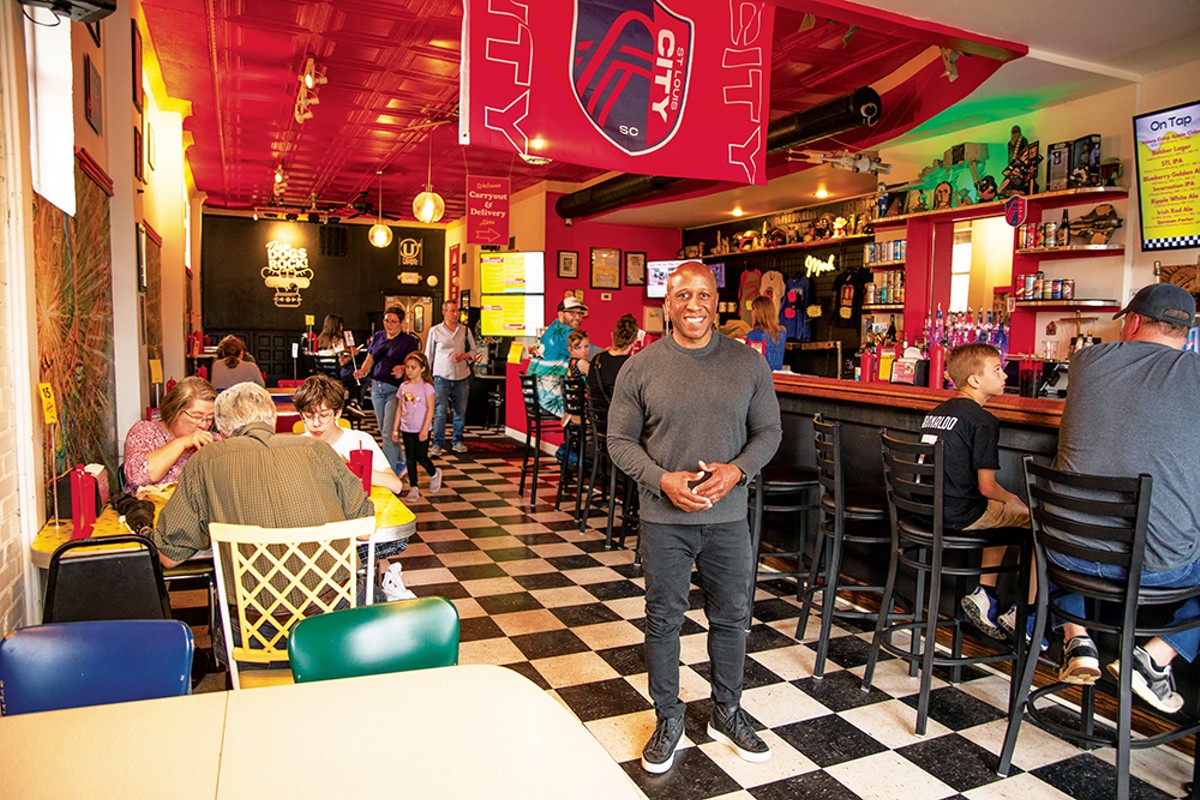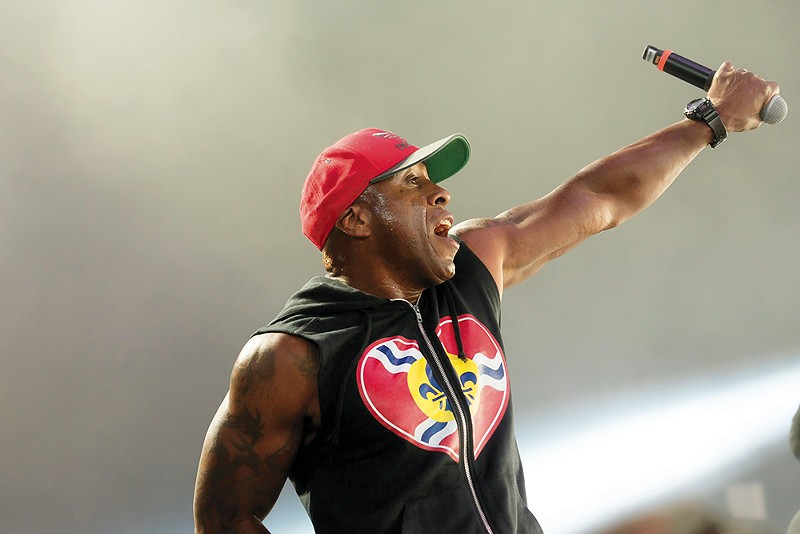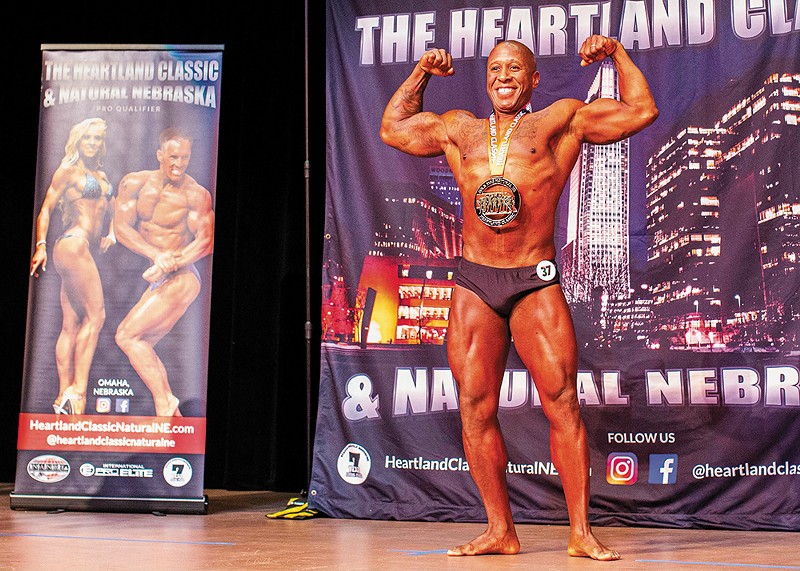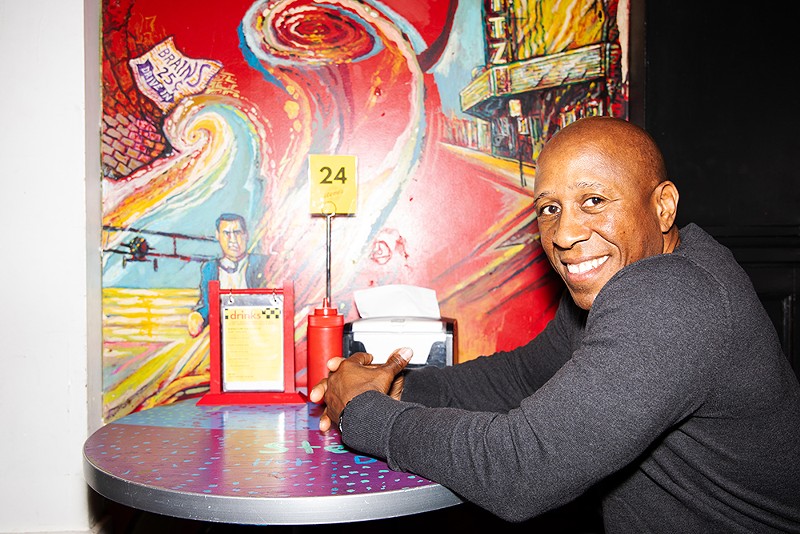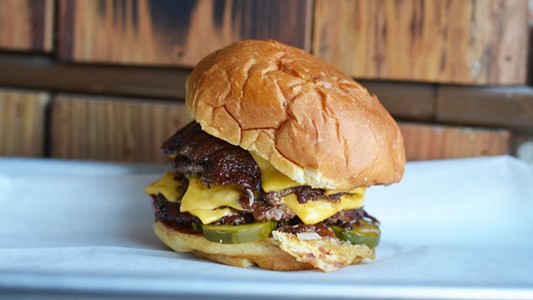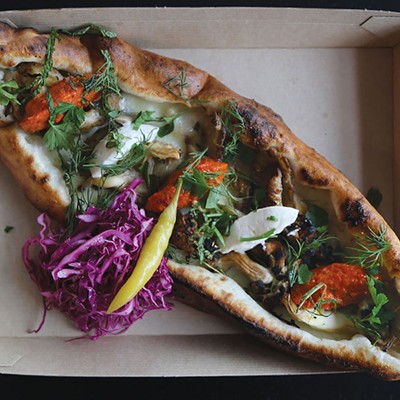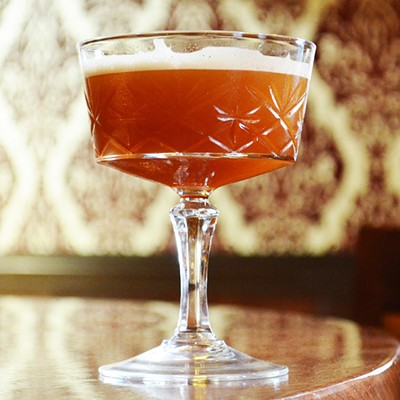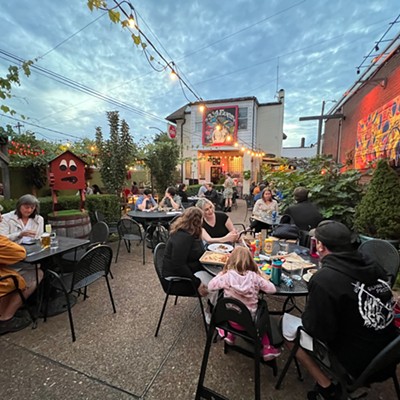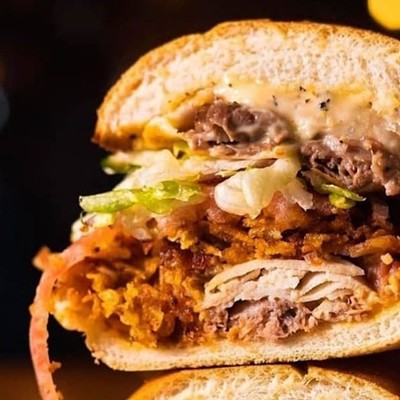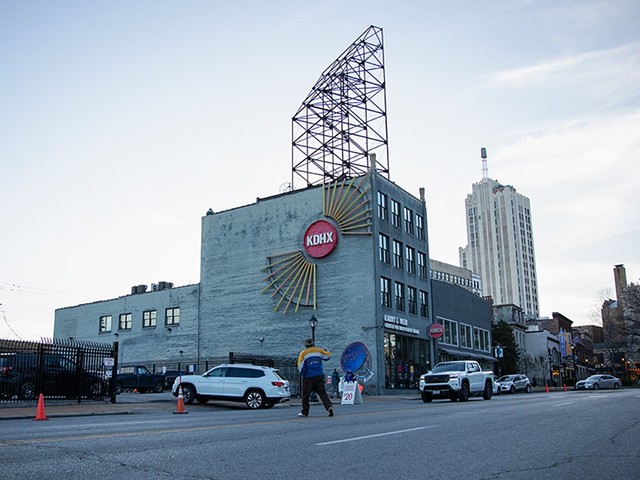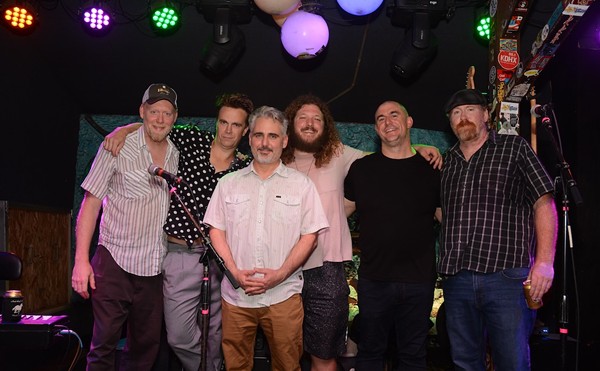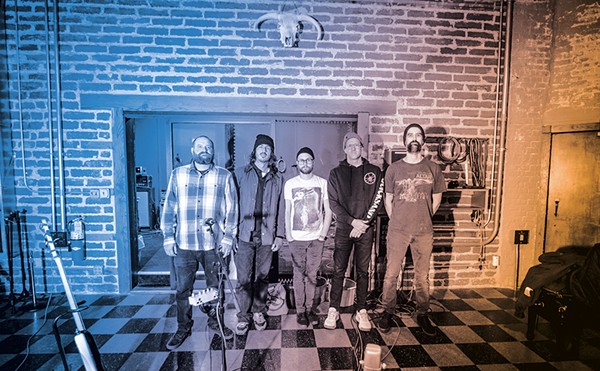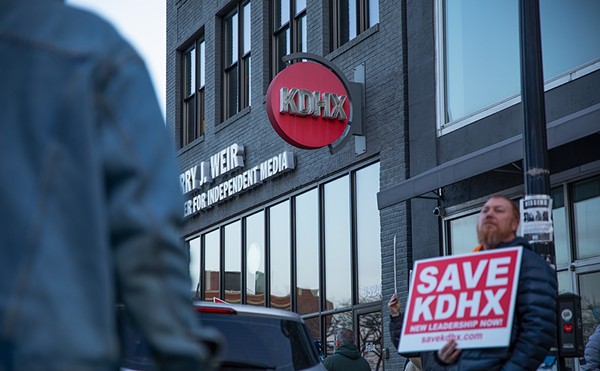When Steve Ewing unlocks the door to Steve's Hot Dogs on South Grand, the flagship location of his growing restaurant chain, he pulls open the door handle, which is shaped like a handheld microphone. There must be incredible muscle memory built into such a grip for Ewing, as he has held a similar microphone during thousands of shows as the lead singer for the Urge and in his various solo configurations dating back to his days as a teenager at Webster Groves High School in the '80s.
It's Monday morning, an hour before the restaurant opens, and Ewing has walked over from his nearby Tower Grove South home, which he shares with his wife and teenage daughter, to talk with me. He's wearing a track suit that covers his compact frame, built solid from decades as a fitness nut and, more recently, as a competitive amateur bodybuilder. On his head is a black Steve's Hot Dogs ball cap, which he takes off occasionally to rub his shiny bald head, a contrast to the Urge's hit-making heyday when Ewing wore dreads down to his shoulders.
The Urge posters and other memorabilia from Ewing's career decorate the place, a marketing strategy since he opened the original Steve's location on the Hill in 2011. Of course the biggest treat for many fans at Steve's restaurants has been the presence of Steve himself, and in the early days after opening, he could often be seen turning dogs on the outside grill. Even today he can be found working the cash register, always taking time to sign autographs and pose for photos with folks who had been buying his CDs and concert tickets for decades.
Now 54, Ewing is used to the attention and still thrives on it. "That's what it's all about," he says of his interactions with fans. But Ewing's life and his approach to success is about a lot of things, and if one thing is clear for this man with a booming restaurant business, a still-flourishing music career, a happy marriage, a medal-winning hobby as a bodybuilder, and two books on the way, it's that he worked his ass off to get here.
For Ewing, life began in Rock Hill. Young Steve was the product of a jazz purist, trumpet-playing father and a Motown-loving mother, who once signed a record deal in a Supremes-style singing group for a label owned by Freeman Bosley, Sr., father of former St. Louis mayor Freeman Bosley, Jr. Ewing's father attended Douglass High School in segregation-era Webster Groves; his mother attended Kirkwood High School.
But Steve, who was born in 1969, was a Webster Groves High School Statesman, a baseball and wrestling standout who attended Turkey Day games and Friendship Dances and other Webster High traditions. And then, one day during his senior year, he got the Urge.
While Ewing sang in the school choir and in church, he says, "I wasn't serious about singing. I was serious about sports." Still, just as his musical tastes were changing, having recently discovered bands like Bad Brains and Fishbone, he became aware of a couple of recent Webster High graduates, bassist Karl Grable and drummer Jeff Herschel, who had started a band, already calling themselves the Urge. "I really admired what they were doing," he remembers. "They had only played a couple of gigs, but you know when you're in high school, you're like, 'Oh my god, they're in a band!' I would walk by the drummer's house after school every day and would hear them practicing in there."
When the band sought a new singer, Herschel's sister, a friend of Ewing's, helped get him an audition. After learning a cassette-full of the group's songs, Ewing found himself the Urge's new lead vocalist, a position he would occupy for the next 37 years and counting.
"By the time I started, I was the only one still in high school," Ewing says. "But I started writing with the band right away." Initially, the music was heavily influenced by bands like U2 and R.E.M., who at the time were breaking from their college-rock roots into the mainstream. Soon, however, Ewing would bring in more of the funk and ska sounds that fans today associate with the Urge. "We were into the Specials and the English Beat and all that," he says. "That really made an impression on me. I got really huge into it. And then we started hanging out with the [Mighty Mighty] Bosstones and some other bands, and everything we started seeing, we just started playing."
The band made a debut cassette in 1988, the year Ewing graduated high school, with the not-very-Ewing-like title Bust Me Dat Forty. Then a four-piece band rounded out by guitarist Pat Malecek, the band added saxophone player Jordan Chalden before releasing Puttin' the Backbone Back in 1989. "We wanted a horn section, but he had to ease into it," Ewing says. "So we got Jordan, who was amazing, really awesome. He added a lot of energy to the show."
That energy became the calling card of the Urge concerts, with the members going for broke the entire show, heavy on the jumping, with horn players stomping all over the stage, Grable bobbing over a bass slung down to his knees, and Ewing's indefatigable whirling, leaping and waggling to the music. The enthusiasm spilled over into the crowd; Urge shows have long been sweaty affairs with a pogoing intensity that often blurs the lines between band and audience.
A couple of early moves helped the Urge blow up. One, they were the first local band in St. Louis to release their music on CD. "Everyone else was still making cassettes," Ewing says. "We wanted to make this investment and make a CD to elevate ourselves past what everyone else was doing locally." Ewing remembers a release party at the old Galaxy club downtown. "We did the soundcheck, and then came back, and there was a line down the entire street to get in. We were, like, 'Oh shit!' So that was the moment when we knew that all the work we'd done over the last few years, the hustling, had started to pay off."
The other break was when Pat Hagin, who was managing Mississippi Nights at the time, took on the Urge as their manager. (Hagin is now the co-owner of the Pageant and Delmar Hall.) He booked them as the opening act for dozens of national acts who came through St. Louis to play the legendary nightclub on Laclede's Landing. "The Bosstones were one of the first ones," Ewing recalls. "It gave us a chance to meet those guys. We opened for Murphy's Law, Public Enemy. So we started touring with some of those bands and building our following on the road."
On tour, Ewing remembers Atlanta as pivotal in breaking the band on a national level. "We played this little bar called the Point, and there must have been like 60 people there," he remembers. "The program director for the Georgia State radio station was there. It's the biggest non-commercial radio station in the country, broadcasting at 100,000 watts on a college campus. So they started playing our song. The next time we came back a few months later, it was sold out. The place was packed."
Despite that college-radio success, Ewing says the Urge never entertained the idea of having songs on Top 40 radio, given the band's heavy blend of funk, metal, ska, reggae and rock. "Nobody playing our kind of music was thinking that we'd be on the radio," he says of the scene in the early '90s. "We're coming out of hair metal, we're coming out of arena rock, we're coming out of the Michael Jackson era, the Madonna era. But we were cool where we were because we saw how all these touring bands were killing it. We were selling out venues that were 500 seaters."
By then, the Urge, now featuring Bill Reiter (replacing Chalden) on saxophone and keyboards, was playing huge Pointfest-style radio festivals in major cities and hanging out with kindred bands like 311, who took the Urge on an extensive tour across the country. The touring grind took a toll on some of the members. "This is when our guitarist and drummer didn't want to be on the road anymore. So we split ways with them," Ewing recalls of Malacek and Herschel. Did Ewing experience a similar burnout? "I was having the time of my life!" he says. "I knew this was what I wanted to do."
The lineup change created a new opportunity with the 1994 arrival of guitarist Jerry Jost and drummer John Pessoni, two graduates of Christian Brothers College High School who had opened for the Urge many times as part of the band Life Without Wayne. Versatile, dynamic players both, Jost and Pessoni, according to Ewing, elevated the Urge to a new level. "They already knew all our material, and they are amazing musicians," he says. "So at that point, I felt like we could do more musically. We had more tools in our arsenal."
Still, the band had not signed with a record label despite considerable success and independent sales of their self-financed 1995 album Receiving the Gift of Flavor. "We were selling thousands of CDs at our shows, but nobody in the industry knew who we were," Ewing says. So, taking a cue from Dave Matthews Band, the Urge stopped selling CDs at their shows and went to retail only, inking a deal with Best Buy and ending up selling 50,000 CDs in St. Louis alone in six months. "So at that point we hit Billboard, and every label in the country was, like, 'Who are you guys?' We said, 'We've been here for a while!'"
The Urge, which had grown to seven members with the addition of two trombonists, signed with Immortal Records, which had launched the careers of Korn and Incubus. The deal gave the band a substantial cash advance, a guarantee of three records and a video for the single "All Washed Up."
More money, upgraded touring amenities, bigger shows: The young frontman must have been partying like a rock star, right? "Not more than anybody else," Ewing tells me with a smile. "Probably less than most people. For us, there was beer or liquor or whatever. But cocaine and all that shit? It was just never part of it."
Plus, he knew that he had to take care of his voice if the Urge wanted to keep touring. "It's hard for a singer to party on the road. Keeping your voice up is OK as long as you take care of yourself. That's the trick. That means no partying. You can't. The guitar player can drink a case of beer and his fingers will still work. My voice will not work. If you're out and you have 40 shows, you have to be disciplined. Because if you wake up the next day with no voice, that sucks."
Indeed, Ewing was always in control, not only guiding the band through smart business decisions but also inspiring the other members to stay physically healthy on the road. These days, it's not uncommon to see portable gyms set up in parking lots outside bands' tour buses, but Ewing was well ahead of the curve. "I was the one who went to bed at night, so I was also the one who got up early," he says. "So every time we hit, I found a gym. And then eventually we started carrying our own gym equipment on the bus. We had a bench and weights, a portable gym. So the crew would set the gym up in the parking lot, and the other bands would be like, 'Aww, dude, can I jump in?' So it became a thing. You gotta stay fit."
I ask Ewing about being the only Black member in an otherwise all-white band and if he ever experienced racism while out with Urge. "Not much, because in our world, there was a lot of [racial diversity] happening," he says. "Fishbone was huge. Living Colour was just coming out. 24-7 Spyz, Bad Brains, King's X, all the ska bands. In our world, it was all mixed up. In the mainstream, it was either Black or white. So it was not a big deal to us. We had our own crowd, our own thing." Was there that kind of racial diversity in the crowds? "The majority of our crowds were all white," he says with a wry laugh. "Still are. Because it's rock music. It's how music is marketed. It sucks. Don't get me wrong. But that's just how it is."
After the record deal, the Urge was back on the road for a grueling 18 months, and felt the pressure of the big leagues, a game with higher stakes. "The label had just invested a shitload of money in us, and they were, like, 'We need hits.'"
In 1998, the band gave them one. While recording a new album, Master of Styles, in Reno, Nevada, the Urge had finished everything, but the label didn't feel they had a single, at which point the band called in an old friend, Nick Hexum, lead singer for their old touring mates 311. "I picked him up in Sacramento, and I sat in the bedroom with him for a couple of hours and worked on the song. We tracked it, and the label was like, 'OK, I think we got something.' And that was the first single. We shot the video for that. and it seriously charted like a motherfucker." The song was the band's skalternative classic "Jump Right In," still the band's signature song, a Top 10 hit on Billboard's Modern Rock chart, featuring the memorable music video with the band performing the song while sitting atop teetering 20-foot poles.
Ewing describes the band's writing process as a collaborative effort with all of the members sitting in a room and writing together, although he is generally in charge of melodies and lyrics. And as the Urge continued, his lyricism and vocal approaches evolved. "The music was changing a little bit. My focus was on digging deep into the lyrics. What am I really talking about? Who am I? I was getting better as a writer, and I was focusing more on melody and harmony, instead of just screaming all the time. I had a good voice, so let's use it for melody. Singing is not hard at all. Lyric writing is hard."
Master of Styles would go on to sell more than a quarter-million copies. In 1998, was that enough to make Steve Ewing and the guys in the Urge rich? "The money was all right," he says. "At this point, we're making enough money to live off of. We were making money from shows, not from album sales. But it was exciting. My attitude was that we needed to make sure we were working hard and capitalizing on this. So we toured our ass off."
Still, things were changing, and the turn of the century also marked a turning point for the Urge. The band went back into the studio to record their next album, 2000's Too Much Stereo, which coincided with the beginning of the collapse of the music retail industry. Once the album came out, the band still toured for a year and put out the title track as a single, which bubbled into the Top 100, along with its video. But the album sold about half of what its predecessor did. Experiencing burnout and musical differences, the Urge broke up after its tour in 2001. "We had differences in what we wanted to do musically, stereotypical band shit," he says. "Plus, the outlook was different. We had been the band on the rise. If you feel like you're not on the rise anymore..."
By this time, Ewing had gotten married and relocated to Los Angeles. With a pile of music he had written and a list of new collaborators in L.A., Ewing put out a series of solo albums in the aughts, incorporating more electronic, looping and hip-hop elements, and touring as the Steve Ewing Band. "I was outside of the Urge completely, so it was almost like starting over again," he says. When his wife, a speech therapist, got pregnant in 2006, the couple moved back to St. Louis to be close to family.
Of course, the Urge never ended for good. The other members continued to live in St. Louis — Pessoni went on to be the classic-rock drummer par excellence in tribute bands like El Monstero, Celebration Day and, with Jost, Joe Dirt and the Dirty Boys. But demand for Urge reunions was always high, and the last 20 years have seen the Urge coming back together for one-off reunions and full-blown resumptions, including a comeback album, Galvanized, in 2013. Such icons are the Urge in their hometown that the St. Louis Blues even partnered with the band in 2018 to create a new goal song, "The Blues Have the Urge," which the team plays whenever the Blues score a goal.
All along, Ewing has continued to play his own shows, mostly as an acoustic duo with guitarist Adam Hansbrough, himself a Webster High graduate, but one 10 years younger than Ewing. "He's a fucking unbelievable guitar player," Ewing tells me. Ewing and Hansbrough continue to play some 200 shows every year.
It was during one of those shows that a whole new idea occurred to Ewing.
"I like food, and I'd seen street food in other cities," he says. "We were playing a lot of shows, and these bars are packed, you walk out after the show, and there's nowhere to eat. I was, like, 'I'm going to get a hot dog cart and put it out at these venues.'" Sure enough, Ewing bought a cart, hitched it on the back of his truck and parked it outside of Steve Ewing shows. Fans who had just watched Ewing perform on stage were surprised and delighted to find the singer himself personally selling hot dogs to hungry late-night revelers.
Next, Ewing took his stand to the old Procter & Gamble factory in downtown St. Louis, selling hot dogs to the factory workers. "I would see a truck driver every 10 seconds," he recalls. "Those drivers couldn't stop to eat, I was literally throwing hot dogs into their trucks." In 2010, he put another stand outside of Scott Air Force Base in Illinois, hiring partner in grilling and smoking ace Joe Zeable to run the stand, now called Steve's Hometown Hot Dogs.
The first permanent Steve's Hot Dogs took over a building on the Hill in 2011, a joint with no kitchen, so Steve ran the grill and smoker outside. "I took all the Urge stuff at my house to the restaurant and put it on the walls," he says. "And that worked big time. People were curious out of the box. 'Why is Steve selling hot dogs?' People were just coming to hang out and see what it was about."
Also key to the success was building a creative menu, and Ewing wanted a list of uniquely constructed hot dogs that would hook customers. "If you have a hot dog joint and tons of toppings and you ask someone what they want, they'll sit there for 20 minutes not knowing what to put on it," he says. "So we're gonna make a menu of really cool, innovative stuff. We were the first ones to do a mac-and-cheese dog here."
It took three years to outgrow the 16-seat location on the Hill, so Ewing opened a second location in Tower Grove East next to Tick Tock Tavern, eventually closing the Hill restaurant. In 2020, Ewing had decided to close the Steve's in Tower Grove also, but when a press release went out announcing the closure, he says, "The entire city basically came and bought a hot dog for the next week. It was crazy."
At that point, Ewing found a new partner in marketing consultant Danni Eickenhorst and reopened Steve's. It's been a smash ever since, even thriving during the pandemic and eventually outgrowing its location. Just then, the old Mangia Italiano space on South Grand was closing, and the current Steve's Hot Dogs moved into half of that space three years ago, this time with a liquor license.
When CityPark was being planned as the home for St. Louis CITY SC soccer, organizers wanted all local food for the stadium's concessions and polled St. Louisans on which venues should be included. Steve's Hot Dogs was an overwhelming favorite. Locations at Enterprise Center and America's Center followed. And now Ewing and Eickenhorst have opened their newest concept, Steve's Meltdown, at City Foundry, with the goal of doing the same thing for grilled cheese sandwiches that Steve's did for hot dogs.
It might seem odd that a guy who runs restaurants specializing in comfort food, with enticing carbohydrates everywhere, including some of the best french fries in town, would also be a bodybuilder who must maintain a painfully fit and lean physique, but here we are. "I was getting ready to turn 50," he says. "And I had some friends who were doing bodybuilding shows. I had always been fascinated with that. It's just fun to get into really good shape and compete."
Ewing's first show had him posing and flexing in front of 3,000 people, and now he has added a pile of bodybuilding medals to his list of accolades. As we chat in his restaurant, with the smell of hot dogs wafting through the place, I ask how he avoids the temptations. "It gets tough!" he says. "Trust me. I walk in here right past the french fries every day. It's hard when you're getting to that point where you're super lean. You're hungry. But I have my built-in cheat meals right here."
Ewing chalks up his lifelong work ethic to where he's from. "I think it's a Midwest thing," he says. "We have a sort of a chip on our shoulder. I think we feel like we have to work harder here compared to bigger cities where there's more industry. We have to do more to be seen."
These days, Ewing is still playing continually with the Steve Ewing Band and in the Steve Ewing Duo, including a recent sold-out show at City Winery. The Urge, which Ewing considers a fully active band, has new singles that will be released later this year and sold-out shows set for Kansas City and Omaha. And he hints that a big concert announcement for St. Louis will be coming soon.
And is Steve's Hot Dogs done growing? "No, not at all," he says. "Expansion is our game right now." Ewing hopes to open locations in St. Louis County and St. Charles County and points beyond. Also in the works is a photo book commemorating Ewing's career, and he is at work sketching out a memoir of his life.
All of which means that Ewing has no more time to sit and talk to me. Before he goes, he recommends that I get the Bacon Bacon Jamaican (listed on the menu as "Steve's favorite!") or the Geddy Lee (named after the Canadian bassist due to the poutine that is piled on the hot dog). I go with the Geddy Lee, as Ewing flashes me a smile on his way out. "You're not going to get one of those anywhere else!" he says. And then he's out the door to jump right in to his next calling.
Subscribe to Riverfront Times newsletters.
Follow us: Apple News | Google News | NewsBreak | Reddit | Instagram | Facebook | Twitter | Or sign up for our RSS Feed

